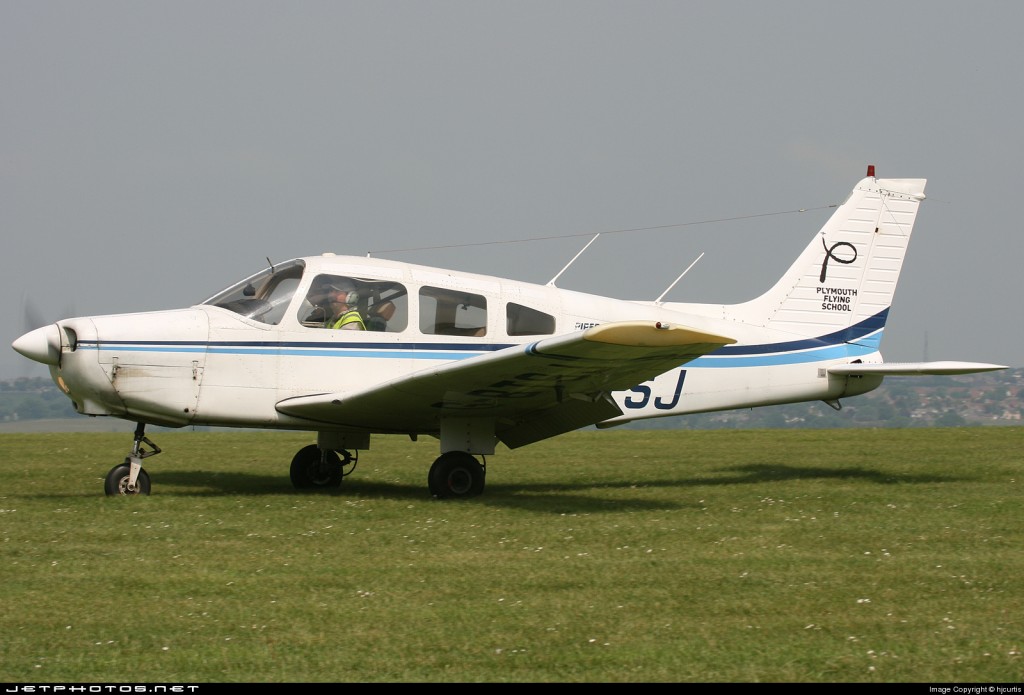As part of good airmanship, a good pilot will practise his safety drills regularly. One such drill is called the Practice Forced Landing, or ‘PFL’ for short. You pretend that your engine has failed, by simply closing the throttle (it’s very much like when you are sitting at a traffic light with your engine just ticking over) and it’s then just a question of ‘simply’ gliding the aircraft down into a suitable field – or nearly so; when you think you would have made the safe landing, you put the power back on and climb away. Job done.
This story happened about fourteen years ago, when I was still flying the Piper Warrior four-seater. Here’s the actual aeroplane in the story:
On this occasion, I had in the aircraft (names changed for embarrassment reasons) my friend Andy and his two sons Mike (16) and Ian (14). We were flying out from Plymouth to the Newquay area and back, and we’d briefed very thoroughly about the flight and talked about what to do in an emergency. I’d mentioned that at some point on the way back from Newquay, I would do a PFL, setting it up as a practice engine failure and practising the whole thing including a practice Mayday call.
Guys, watch what I do and be impressed; the whole thing is a bag of fun.
So off we trot with Andy in the front and the two boys in the back; we managed to find Newquay and then turned back towards Plymouth. About half-way back, I let everyone know what was happening. ‘OK guys, remember the practice engine failure drill? I’m commencing now; watch and learn!”
Carb heat to ‘hot’, throttle closed. Everything goes quiet, just the sound of the windrush on the aircraft to be heard. On with the drill. Trim for the glide. Pick a field. Plan the circuit and set the aircraft up for it. Restart drills – fuel, mixture, throttle, magnetos, fuel pump; no joy (of course not, I’m practising a complete engine failure, innit), committed to land. Practice Mayday call (say the Mayday call out loud but don’t press the transmit button or the Press will think there’s about to be another of their favourite ‘plane crash’ incidents). Height: 1,000 feet; field one mile away. It’s looking good: plenty of height so preliminary flap selection; ten degrees of flap. Mike leans over my shoulder, “Which field did you say we’re going in to?” (Oh that’s good, he’s showing an interest in what’s going on!)
“That big field there, with the farmhouse next to it”.
“Oh, ok”.
600 feet. Final flap selection. Committed checks: mime the actions – Fuel off, magnetos off, master switch off, straps tight, doors open.
“Which field was it again?”
“That one right there, with the track across the middle”
“Oh, ok”.
500 feet. Ok, if that had been a real emergency, we’d have lived for sure. Good. Practice emergency completed: carb heat ‘cold’, select full power (everything gets noisy again), prevent the strong nose-up pitch tendency, re-trim for climb power, positive rate of climb, flaps up, engine temperature and oil pressure in the green. Climbing to cruise altitude, establish track back to Plymouth.
Mike leans over again. “I thought you said the engine had failed?”
Suddenly it all made sense. The poor kid had forgotten that this was a drill; everybody else knew that there was no engine failure, it was just a practice. But for him, this was his first real in-flight emergency. He seriously thought that we were going to be in a field with sheep for company until the emergency services arrived. If we were lucky.
“Didn’t you remember? I told you before we set off that I was going to do a practice emergency; that was it!” Mike sat back in his seat, very relieved and (to his credit) with clean underwear too.
There’s an epilogue too, which is pretty important considering what had happened. About ten miles out from Plymouth, I was setting up the aircraft for circuit rejoin and landing when all of a sudden a fight broke out in the back seat. Andy turned round immediately and stopped Mike laying into his brother Ian. “Idiots! Fighting in a plane! You’re going to get us all killed!!” Things calmed down pretty sharpish…..
Then I learned after we’d landed that the reason why Mike had started hitting Ian was that, as soon as I had ‘failed’ the engine, Ian had leaned across and muttered to his older brother, “The engine has failed; we’re going to crash!” Ian, of course, knew exactly what was going on and was just winding him up.
So, for poor Mike, this was, to all intents and purposes, his first real brush with death in an aviation sense. And the lessons I learned? Only do a PFL if the passengers are a) veteran light aircraft passengers, and b) thoroughly briefed on what is going on. Yes, I’d briefed them, but they were obviously too excited to take it all in.
Well, we live and learn!
